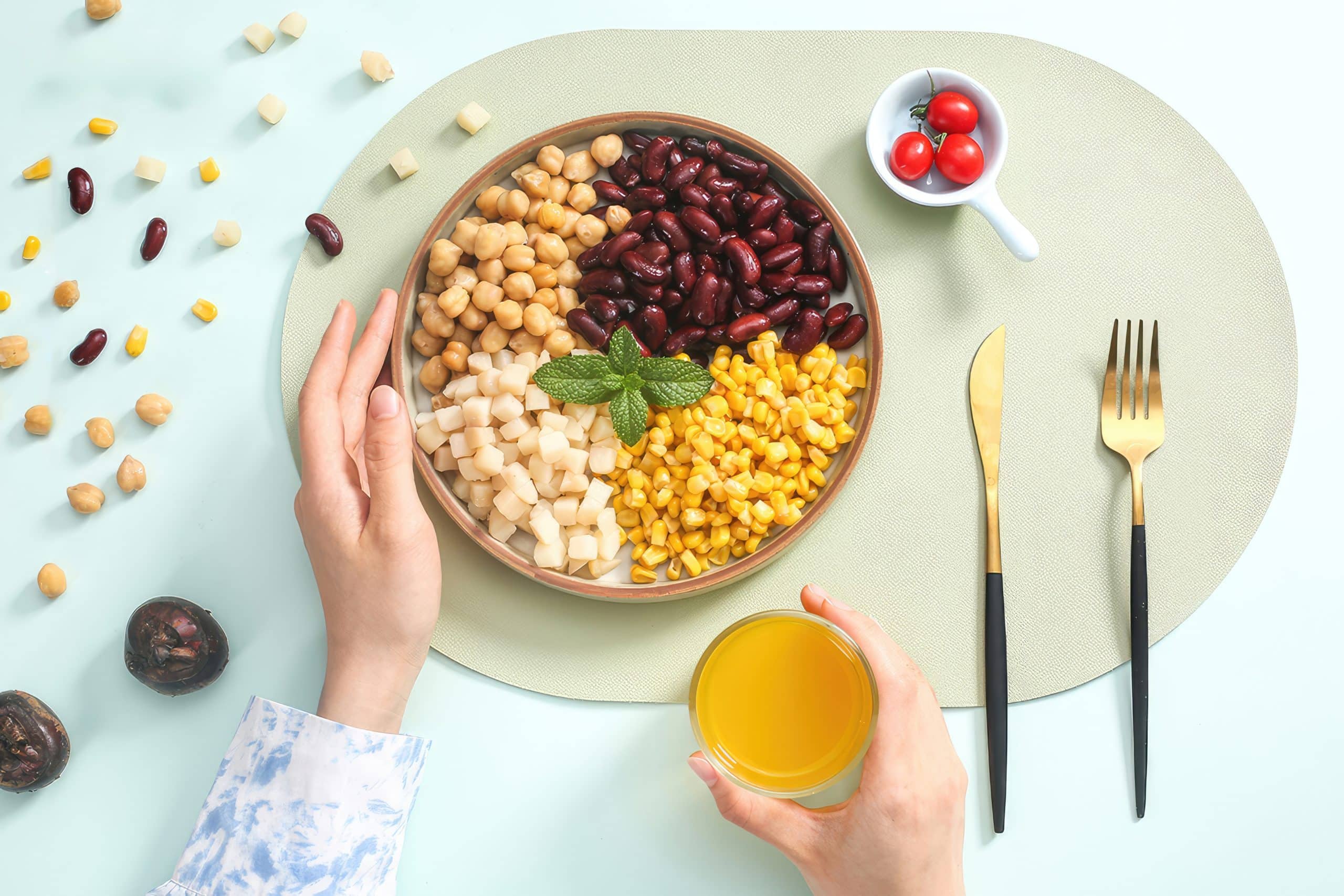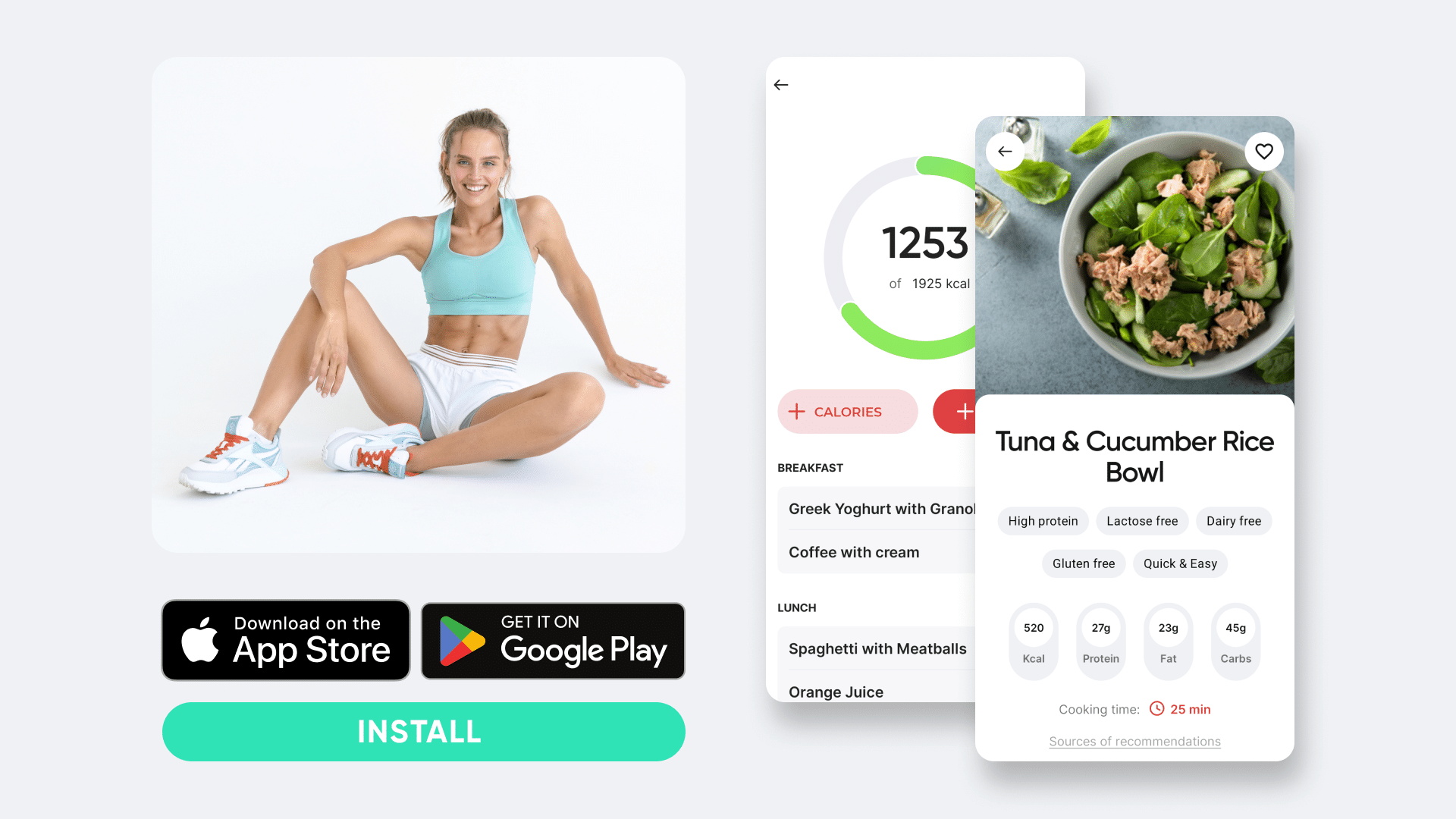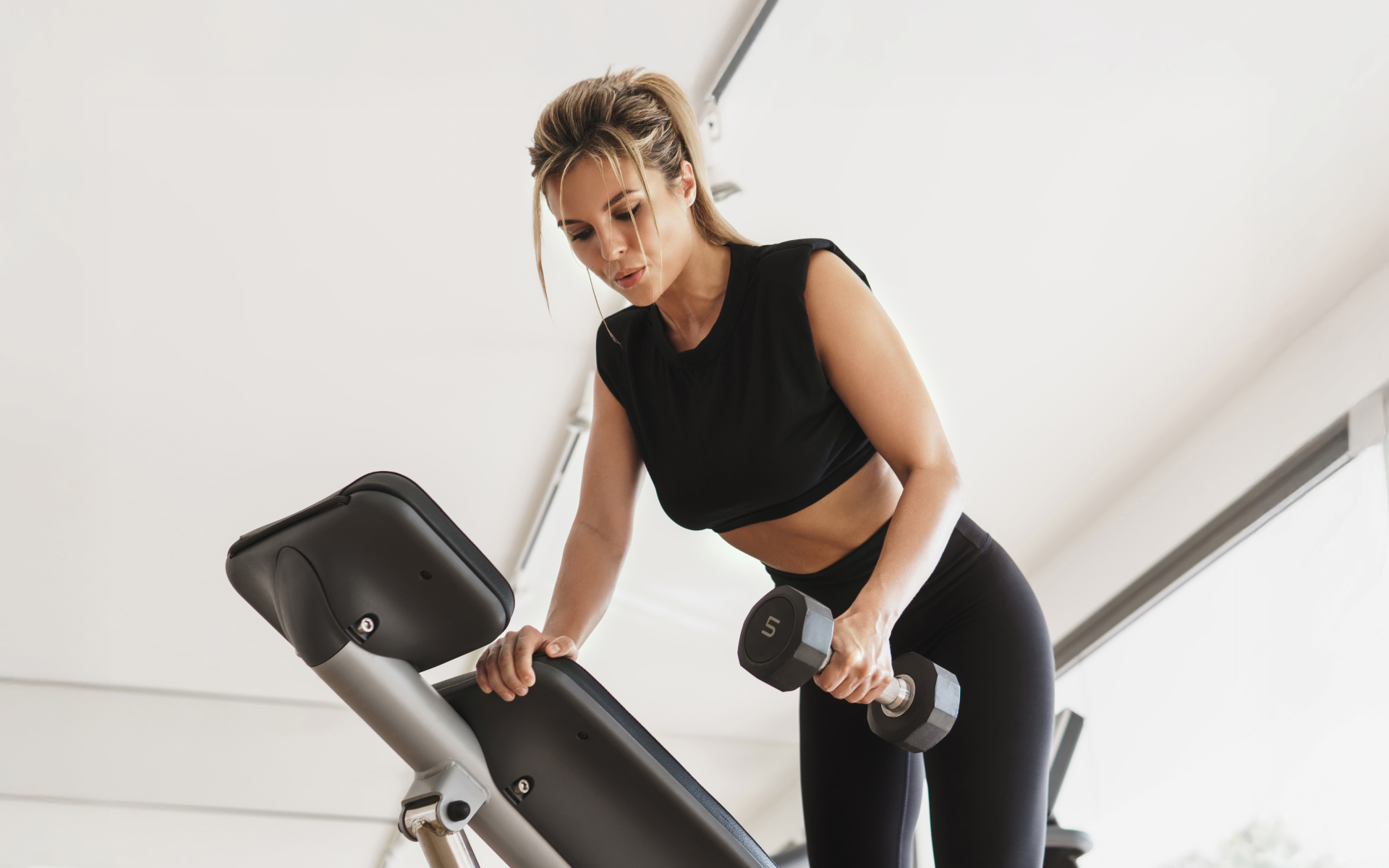According to the National Library of Medicine, the daily average calorie requirements for the average man is 2500 kcal and for a woman is 2000 kcal. This is enough to keep the average person going and help them maintain their current weight (1). However, the average does not apply to everyone.
As we all know, how many calories you are supposed to get in a day is dependent on several factors including but not limited to your sex, height, weight, activity level, and age (1). People who workout a lot – especially athletes or those in the body building space may find themselves on a daily 3300 calorie plan.
What does such a meal plan look like? Can anyone start eating like this or is such a diet limited to a specific niche group of people? Can you make a 3300 calories meal plan low carb or is this impossible?
Read on to find out!
Is 3300 Calories A Day A Lot?
Before you start looking up a 3300 calorie meal plan that is for vegetarian, high protein, vegan, etc. type diets, we must warn you that for the average person, a 3300 calorie diet is high. Actually, far more than what is recommended for most people to consume.
As mentioned above, the average man/woman requires only 2500/2000 calories a day to help maintain their weight. Looking at these numbers we can see that opting to consume a 3300 kcal diet will go over the recommended calorie intake by 800 to 1300 kcal for the average man or woman. This is just not a good idea.
Even if you are looking to add some extra weight, this number is still quite excessive. To add weight gradually and safely, people are usually advised to increase their daily calorie intake by an extra 300 to 500 kcal. In some cases, some may choose to increase by 700 to 1000 kcal, but this is likely to result in more fat storage..
In a study published in 2014, researchers took 25 healthy individuals and placed them in an inpatient overfeeding experiment for 56 days (8 weeks total). During this time the patients were fed 140% of energy needs (an extra 950 kcal from their normal intake).
At the end of the study, researchers noted that the study participants gained an average of 11.7 pounds (5.3 kg). They also noted that of this 11.7 extra pounds, 7.7 pounds (3.5 kg) was made up of fat (5).
Some people may need to gain body fat for health reasons. Others, including many bodybuilders, prefer to increase their weight by adding lean body mass, and not too much fat. Remember that excess fat in the body may put you at a higher risk of type 2 diabetes, coronary heart disease, stroke, fertility and pregnancy problems, some cancers, high blood pressure, fatty liver disease, sleep apnea, as well as mental illness such as clinical depression, anxiety, etc. among many other issues (7, 6).
Who Should Follow A 3300 Calorie Meal Plan: Exceptions To The Rule
With that said, some people can consume 3300 kcal, without it being too much and without the risk of drastic weight gain. These include:
Persons with hypermetabolism
Hypermetabolism is a state of accelerated metabolic activity. It’s a condition whereby your body’s basal metabolic rate (BMR), or the amount of calories required to perform basic, life-sustaining functions when the body is at rest increases from the normal levels.
Hypermetabolism can be caused/triggered by several factors including suffering severe burns, experiencing multiple fractures, infection or sepsis, traumatic brain injury, suffering from cancer or having undergone surgery. In such a case, the body becomes hypermetabolic, effectively increasing energy consumption in order to facilitate the healing process (9, 10, 8, 15).
Because of this, such patients may end up needing up to 3000 calories or more in a day. However, because each patient is different, it is best to consult the healthcare team to see how much they can and should eat a day while undergoing treatment/recovering.
Anyone in a bulking phase
Bulking is a term often used in the bodybuilding space. The term refers to a phase where someone eats a lot more than they normally would – more than their body needs – in order to gain weight.
The progressive increase of calories intake is always accompanied with intense weight training because the people bulking are looking to add weight in the form of more muscle – not fat. During this phase, bodybuilders are recommended to increase their daily caloric intake by 10% to 20% (14).
One review published in 2014 found that on average male and female bodybuilders in the bulking phase of their fitness routine tend to consume up to 3800 kcal and 3200 kcal, respectively (3, 13).
If you struggle to even flirt with the idea of giving up your favorite foods or working out till your legs give way – BetterMe app is here to breathe a fresh perspective into the way you view the weight loss process! Check out the app and experience the fun side of fitness and dieting with BetterMe!
How Many Carbs Is In 3300 Calories?
According to a study review published in 2004, researchers suggested that bodybuilder should divide up their daily macronutrient amounts for both the off-season and pre-contest phases as follows (12):
- 55 to 60% of energy from carbohydrate
- 25 to 30% of energy from protein
- 15 to 20% of energy from fat
They also suggested that during the cutting phase (aka pre-contest phase), body builders should cut their daily energy intake by 15% and increase it by approximately 15% during their off-season (bulking) phase (12).
So what does this mean for carb intake on a 3300 calorie meal plan? If you choose to stick to the above parameters, then 1815 to 1980 kcal of your daily intake should come directly from carbohydrates.
(3300 kcal x 55) ÷ 100 = 1815 kcal or 454 grams of carbohydrates
(3300 kcal x 60) ÷ 100 = 1980 kcal or 495 grams of carbohydrates
However, if you plan on following a 3300 calorie low carb meal plan, then your carbs for the day are going to be much lower than this. Depending on how long you want this carb intake to be, you can stick to the following parameters (11):
- Less than 10% carbs (equating to 20 g to 50 g carbs a day) – very low carbohydrate diet (also known as a ketogenic diet)
- Less than 26% carbs intake a day (less than 130 g/day) – low carbohydrate diet
3300 Calorie Meal Plan Ideas: Simple Sample To Get You Started
If you have no idea how a day of eating on a 3300 calorie meal plan would look like, here is a day of meals to help give you an accurate idea
Breakfast – Sesame Egg with Broccoli
Ingredients:
- 1 tbsp sesame seeds
- 1 ½ chopped broccoli
- 3 large eggs
- 1 tsp olive oil
- 1 tsp sesame oil
- 1 tsp crushed red pepper flakes
- Salt & pepper to taste
Directions
- Heat a medium skillet over medium-high heat
- Once the pan is hot enough, add the sesame seeds and toast till they turn brown and become fragrant. Take off the pan and set aside
- Add the oils to the pan and heat, then add beaten eggs. Cook for about a minute, fold them in half and take them off the pan and set aside
- Add the broccoli and chili peppers to the same pan, and saute till cooked
- Break apart the egg (or cut into ribbons with a knife) and add them back to the pan with the broccoli. Top with salt and pepper and toss to combine everything
- Transfer to a bowl and top with the toasted sesame seeds
Calories: 397.1. Fats: 28.5 g. Protein: 24.5 g. Carbs: 13.3 g
Snack 1 – Fig, Cheese & Sesame Toast
Ingredients
- 1 slice whole wheat bread
- ¼ cup ricotta cheese
- 2 dried figs
- 1 tsp toasted sesame seeds
Directions
- Toast bread as desired
- Slice the dried figs, spread cheese on toast, place figs on top and sprinkle with sesame seeds
Calories: 225.5. Fats: 27.1 g. Protein: 8.4 g. Carbs: 27.1 g
Read more: A Beginner Intermittent Fasting Meal Plan To Fit Your IF Journey
Lunch – Stuffed Peppers
Ingredients
- 1 cup canned crab
- ½ cup cherry tomatoes
- 1 cup canned corn
- 1 tbsp olive oil
- 1 tsp lemon juice
- 3 sprigs fresh cilantro
- 1 medium-sized red bell pepper
Directions
- Clean and chop the tomatoes and cilantro
- In a sizeable bowl, combine the chopped tomatoes and cilantro with the drained crab, corn, olive oil and lemon juice
- Cut the bell pepper lengthwise in half and remove the seeds. Add the ingredients in the bowl in each half of the bell pepper
Calories: 400.8. Fats: 17.3 g. Protein: 29.9 g. Carbs: 35.4 g
Lunch ‘dessert’ – Fruit & Peanut Butter
Ingredients
- 1 medium-sized peach
- 2 tbsp peanut butter
Directions
- Clean, pit and slice the peach
- Add the peanut butter to a small bowl. Dip the peach slices to the peanut butter and enjoy
Calories: 247. Fats: 16.4 g. Protein: 9.1 g. Carbs: 21.2 g
Snack 2 – Strawberry Smoothie
Ingredients
- 1 scoop whey protein
- ½ cup strawberries
- 6 almonds
- ½ tbsp honey
- 1 ½ cup almond milk
- Ice cubes
Directions
- Place everything in a blender and blend till smooth
Calories: 322.3. Fats: 27.5 g. Protein: 8.3 g. Carbs: 35.2 g
Dinner – Garlic Rice with Tilapia and Kale
Ingredients (for the garlic rice)
- 1 tbsp olive oil
- 3 cloves minced garlic
- ½ cup long grain white rice
- 1 ½ cup water
- Salt to taste
Directions
- In a medium-sized saucepan, heat the oil over medium heat. Add the garlic and cook till it becomes fragrant – this should take about 30 seconds
- Add water to this and let it come to a boil. Once boiling add the rice, reduce the heat to low and cover the saucepan
- Cook the rice for approximately 15 minutes. Remove from the heat and toss with a fork
Calories: 470.4. Fats: 14.2 g. Protein: 7.2 g. Carbs: 76.9 g
Ingredients (for the fish (17)
- 12 oz (340 g) tilapia
- 2 ½ olive oil
- 1 mince garlic clove
- 4 cups chopped kale
- 1 cup chopped tomatoes
- Salt and pepper to taste
Directions
- Season both sides of the tilapia with salt and pepper and set aside.
- Heat the oil in a large skillet over medium high heat
- Add the kale and garlic and cook for 1 minute. Stir throughout
- Add the tomatoes, combine and cover to bring to a boil. Make sure to reduce the heat to low
- Place the tilapia over this mixture, cover the pan and cook for 1 minute. Gently turn the fish over and allow everything to cook for another 2 to 3 minutes
- Remove from the heat and serve with the rice
Calories for the tilapia: 594.8. Fats: 19.9 g. Protein: 81.6 g. Carbs: 31.6 g
Whether you’re a workout beast or just a beginner making your first foray into the world of fitness and dieting – BetterMe has a lot to offer to both newbies and experts! Install the app and experience the versatility first-hand!
Snack 3 – Curry Popcorn with raisins
Ingredients
- 3 cups popcorn
- 1 ½ tbsp butter
- 1 tsp curry powder
- ⅛ cup seedless raisins
Directions
- Pop the popcorn and place them in a bowl with the raisins
- Melt the butter and quickly pour it in the bowl with the raisins and popcorn
- Sprinkle the curry powder over everything and toss everything
Calories: 306.3. Fats: 18.7 g. Protein: 4.1 g. Carbs: 34.2 g
Snack 4 – Greek yogurt with berries
Ingredients
- ⅓ cup sliced strawberries
- ⅓ cup raspberries
- 1 cup plain greek yogurt
- 2 tbsp walnuts
- ½ tsp cinnamon
- 1 tbsp honey
Directions
- Add the yogurt to a bowl. Top with berries and walnuts, drizzle honey, sprinkle cinnamon and enjoy
Calories: 344.3. Fats: 10.6 g. Protein: 29.2 g. Carbs: 37.6 g
Total intake for the day: Calories: 3308. Fats: 142.2 g. Protein: 224.8 g. Carbs: 312.6 g
How To Follow A 3300 Calorie Meal Plan High Protein
High protein diets are often suggested for people looking to lose weight, due to their benefits for helping with weight and fat loss (2). However, a high protein diet can help with bulking and muscle gain too – especially when combined with weight/resistance training (4, 16).
If you’d like to follow a 3300 calorie high protein diet, we suggest you keep your fats and carb intake moderate and increase your protein. You can get more protein in your diet by consuming more meat, fish, dairy products, beans and legumes, eggs, as well as high protein vegetables like broccoli, collard greens, asparagus, mustard greens, spinach, etc.
Can A Person Eat 3000 Calories A Day?
Yes, they can. However, such a diet is only for a very specific group of people i.e
- Men who on average need 2500 kcal a day and are looking to gain weight
- Women and some men who are into fitness and are in a bulking phase, hoping to increase their muscle mass.
Read more: Vegan Weight Loss Meal Plan and Prep Tips
FAQs
Are Calorie Deficit Breakfasts Good For A 3300 Calorie Meal Plan?
No, they are not. The whole point of such a meal plan is to eat more. Choosing calorie deficit meals is doing the exact opposite of what you should be doing, because they likely don’t provide enough calories to help you get to your daily total.
How Many Meals Is 3500 Calories A Day?
It is best to break down such a meal plan into 4 or more meals a day. Because you are eating quite a lot, trying to keep the intake to just 3 meals may mean eating too much at once which can result in indigestion.
Is 2500 Calories Overeating?
Yes and no. For the average man, 2500 kcal is approximately what he should be eating to maintain his weight. However, for the average woman, 2500 kcal is more than she needs and may lead to weight gain over time.. However, not everyone is the “average” man or woman.
With that said, for many people (male or female) looking to gain weight or especially muscle, 2500 kcal will probably not be considered overeating. It all depends on your level of physical activity per day, and your individual resting energy requirements.
Is 1400 Calories Overeating?
No, it is not. The average adult usually requires more than 1400 calories a day to maintain their weight. However, if you lead a sedentary lifestyle and/or are looking to lose some weight, it is best to consult to see if 1400 is too much or just enough for your goals. You can do this by speaking to a registered dietitian or using a reputable calorie counter.
Is 700 Carbs Too Much?
It depends on how many calories you eat in a day and your goals. For those who are carb loading and have high energy needs, 700 grams of carbs may not be too much. For most people, however, 700 grams of carbs is a lot. 700 grams of carbs provides 2,800 calories. Assuming carbs make up 65% of your energy intake, that would suggest a 4,300 calorie per day diet, which is more than most people require.
Is Burning 3000 Calories A Day Good?
If you eat 3000 plus calories a day, then yes, burning 3000 calories, through BMR, physical activity and thermogenesis is perfectly okay. However if you don’t eat this many calories, then trying to burn this much may be detrimental to your health.
Is 3300 Calories Good For Bulking?
As evidenced above, 3300 kcal a day can be good for bulking, especially for body builders. However, it is always smart to determine your individual energy needs for your goals, rather than relying on a generalized calorie level.
Kilocalories Vs Calories: What Is The Difference?
There is no difference in kilocalories and calories. A kilocalorie = a Calorie meaning these two terms refer to the same thing. They can be used interchangeably.
Should I Follow A Metabolic Diet For 13 Days?
Not really. A metabolic diet is a fad diet that promises to help you lose a large amount of weight in a very short amount of time. It promises that through the consumption of some foods and elimination of others, you can completely alter your metabolic rate leading to miraculous weight loss results.
Most of these diets are highly restrictive which is rarely healthy and following them might slow your metabolic rate even more. If you want to speed up your metabolic rate we suggest
- Adding more weights to your fitness routine
- Start working out if you aren’t already
- Increase the intensity of your workouts
- Sleep more
- Drink more water
- Increase your protein intake
The Bottom Line
While a 3300 calorie plan is not something that should be enjoyed by the average person, it is one that might be consumed by someone in body building who wants to bulk up. It may also be consumed by some sick patients, but this should be under a doctor’s guidance and supervision. If you do not fall under any of these two categories, please consider another diet to avoid excess weight/fat gain.
DISCLAIMER:
This article is intended for general informational purposes only and does not serve to address individual circumstances. It is not a substitute for professional advice or help and should not be relied on for making any kind of decision-making. Any action taken as a direct or indirect result of the information in this article is entirely at your own risk and is your sole responsibility.
BetterMe, its content staff, and its medical advisors accept no responsibility for inaccuracies, errors, misstatements, inconsistencies, or omissions and specifically disclaim any liability, loss or risk, personal, professional or otherwise, which may be incurred as a consequence, directly or indirectly, of the use and/or application of any content.
You should always seek the advice of your physician or other qualified health provider with any questions you may have regarding a medical condition or your specific situation. Never disregard professional medical advice or delay seeking it because of BetterMe content. If you suspect or think you may have a medical emergency, call your doctor.
SOURCES
- Calories (2022, ncbi.nlm.nih.gov)
- Clinical Evidence and Mechanisms of High-Protein Diet-Induced Weight Loss (2020, ncbi.nlm.nih.gov)
- Dietary Intake of Competitive Bodybuilders (2015, pubmed.ncbi.nlm.nih.gov)
- Dietary Protein and Muscle Mass: Translating Science to Application and Health Benefit (2019, ncbi.nlm.nih.gov)
- Effects of weight gain induced by controlled overfeeding on physical activity (2014, ncbi.nlm.nih.gov)
- Health Effects of Overweight and Obesity (2022, cdc.gov)
- Health Risks of Overweight & Obesity (2023, niddk.nih.gov)
- Hypermetabolism and Nutritional Support in Sepsis (2018, pubmed.ncbi.nlm.nih.gov)
- Hypermetabolism and symptom burden in advanced cancer patients evaluated in a cachexia clinic (2015, ncbi.nlm.nih.gov)
- Hypermetabolism following Moderate to Severe Traumatic Acute Brain Injury: A Systematic Review (2009, liebertpub.com)
- Low-Carbohydrate Diet (2023, ncbi.nlm.nih.gov)
- Macronutrient considerations for the sport of bodybuilding (2004, pubmed.ncbi.nlm.nih.gov)
- Nutritional Recommendations for Physique Athletes (2020, ncbi.nlm.nih.gov)
- Nutrition Recommendations for Bodybuilders in the Off-Season: A Narrative Review (2019, ncbi.nlm.nih.gov)
- Postburn Hypermetabolism: Past, Present, and Future (2016, academic.oup.com)
- Recent Perspectives Regarding the Role of Dietary Protein for the Promotion of Muscle Hypertrophy with Resistance Exercise Training (2018, ncbi.nlm.nih.gov)
- Tilapia with Kale and Tomato (n.d., eatthismuch.com)











